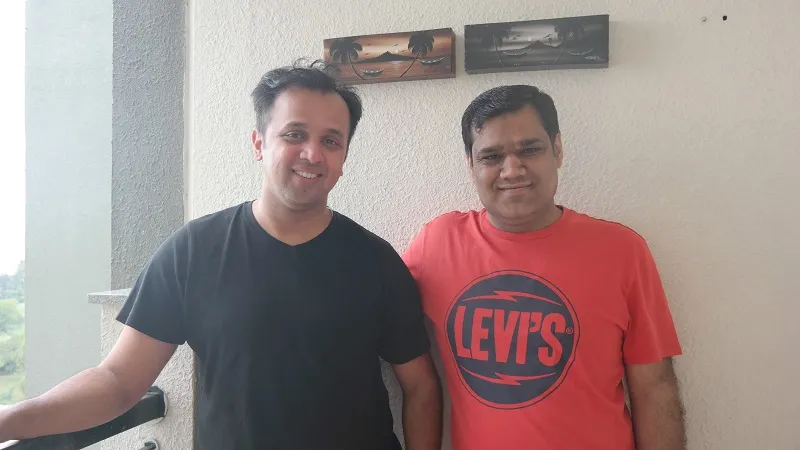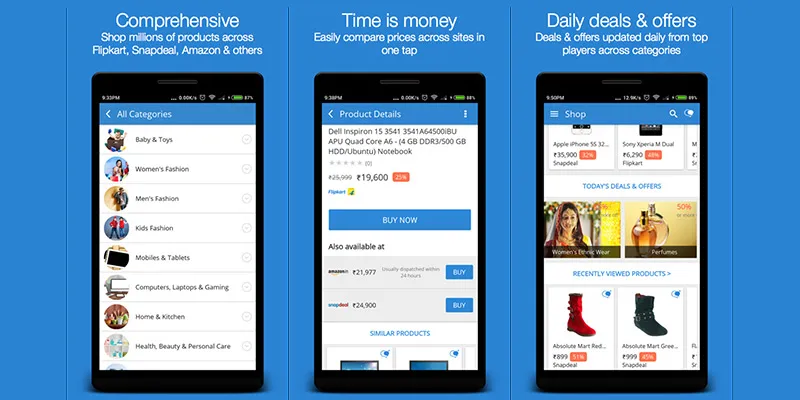Ex-Yahoo! veterans want to make online shopping collaborative with ShopInSync
E-commerce platforms have made shopping more convenient, but the ease of shopping online has led to other problems like impulse buys and buyer’s remorse, especially for high-ticket items. One possible solution is to make online shopping a collaborative experience among friends and family to help people make more informed buying decisions.
Two ex-Yahoo! employees have decided to achieve exactly this with a new mobile app, ShopInSync.

What is it?
ShopInSync offers easy price comparison and the ability to exchange information, share product details and interact with friends and family while trying to zero in on a product through an integrated (in-app) messaging service.
The ShopInSync app curates millions of products from leading e-commerce platforms including Flipkart, Snapdeal and Amazon and offers price comparisons for products in 12 major categories ranging from fashion and kids’ products to electronics and home appliances, among others.
The story so far
ShopInSync, headquartered in San Francisco, was founded in July 2015 by Raj Ramaswamy and Ashish Parnami. Raj is the CEO of the company and was earlier a product management and revenue executive at Yahoo!, while Ashish was a product and engineering leader at the same company. The startup also has an office in Bengaluru.

Starting with their personal experience, which they followed up with extensive market research, Raj and Ashish realized that online shopping in India is mostly a solitary experience. They also discovered that while price is often a deciding factor, insights, inputs, suggestions and validations from close friends and family also significantly influence a consumer’s buying decisions.
At the same time, getting inputs from friends and family has been a disjointed experience, as people need to send links or screenshots over email, chat or discuss options on the phone and then go back to the site to make the purchase. Moreover, the sheer volume of products available with each player magnifies the problem of plenty. Spoilt for choice, users need to either monitor multiple e-commerce platforms or rely on a trusted price comparison platform. And go back to discussing these options with others on the phone or via chat.
Having collated these pain points, Raj, Ashish and their team of four engineers developed a mobile app solution to make online shopping more social and seamless. Raj explains,
We designed ShopInSync to serve the unique needs of the Indian shopper. While comprehensive range and finding the best value are among the top factors influencing a purchase, the majority of decisions are made in consultation with family and friends. We want to connect these elements and enable a seamless and connected shopping experience.
The app is currently available on Android; an iOS version is in the works. The founders have gone with a mobile-first strategy, and a desktop version hinges on user feedback and demand.
How it works

Based on a user’s browsing pattern and interaction, the app throws up recommendations such as top deals and offers. There’s also a section to monitor price, rating and other details of their most discussed products.
Currently, ShopInSync is monetized through affiliate channels and through a small cut it receives on every transaction made via the platform. Going forward, Raj and Ashish plan to further monetize the app by charging brands or platforms a premium to showcase their products in the app’s ‘featured section’ and through other custom offerings. The current focus, of course, is on further improving the product and getting more users on board.
Sector overview and future plans
E-commerce in India is growing rapidly – NASSCOMM estimates sales are likely to touch $100 billion by 2020. In the wake of this growth has followed a flurry of players providing custom tools to help consumers make better decisions. Price comparison platform BuyHatke had raised $1 million from Kris Gopalakrishnan and BEENOS in May 2015. In August, Flipkart launched Ping to allow users to chat with their friends while shopping. Other interesting startups in this sector are Voodoo, a TechSparks 2015 startup that raised $1 million in seed funding for its shopping digital assistant, which provides price comparisons. Then there’s Pricemojo, a mobile app that allows customers to directly chat and bargain with local commerce players.
ShopInsync wants to differentiate itself by providing not only price comparison across multiple platforms but also a social messaging option. Going forward, the team aims to add product categories on the platform and curate products from many more e-commerce platforms. The founders have so far bootstrapped the venture and are currently looking to expand the team. They aim to raise external funding once they achieve certain usage metrics.
YourStory take
ShopInSync is a well-designed and executed mobile app that makes shopping more fun and social without having the conversation spill over to other chatting apps or phone calls. Adding more features and introducing a gaming element into the app should make it stickier for end-users. For instance, users could be rewarded with redeemable points every time a friend or family member buys a product based on their recommendation.
Based on this data, a leader board could be generated for different product categories and help people to reach out to ‘experts’ in the respective product categories, i.e., people whose recommendations have been used or liked the most.
Another feature ShopInSync can explore is provide buying recommendations and a social platform for specific purposes or events. For example, a family may be renovating their home and not have a clear idea of all the possible products they need for their living room. Suggestions through a ‘Did You Forget’ section would make the process easier.
Other possibilities include recommendations for gifts for events such as weddings or other family functions. Given that the team has experience working in both in India and the US for more than a decade, it will be interesting to see how ShopInSync goes about improving the product and getting more users on board.
Website: www.shopinsync.com
(With inputs from Emmanuel Amberber)







